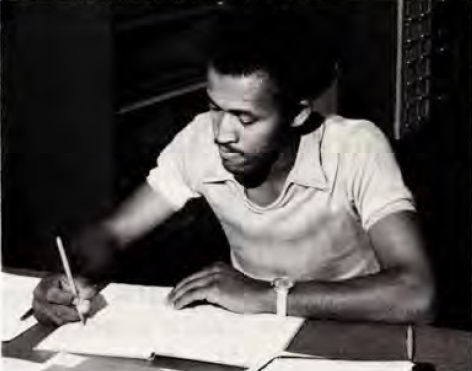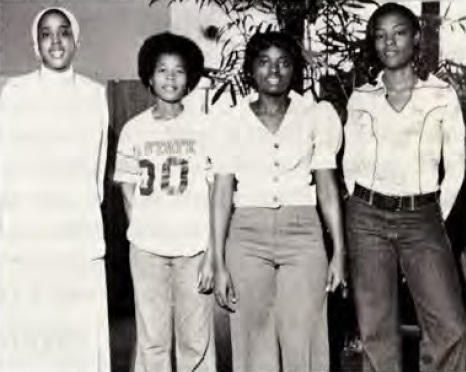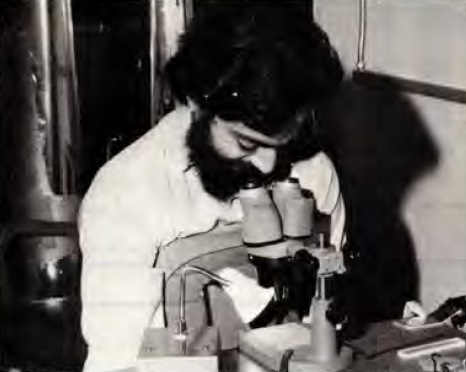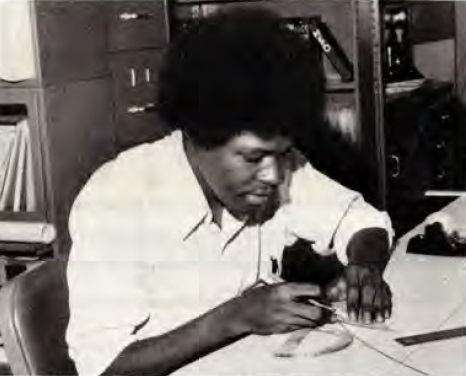Nineteen Students Participate in Fermilab's Fifth Summer Program for Minority Students
Nineteen students from colleges and universities from throughout the United States are participating in Fermilab's 1975 Summer Program for Minority Students. Participants were recruited and selected with the assistance of the Laboratory's Summer Program Advisory Committee. More than three-fourths of the students are majoring in physics and the remainder in either mathematics or engineering.
The objectives of the program and the methods proposed for implementing them have undergone major revisions since the program was organized in 1970. The original "job program" as it was referred to at that time was designed primarily to assist the students in developing technical skills. The basic aim of the current program, in its broadest sense, is to encourage minority students to pursue careers in physics or closely-related fields by giving them direct experience working in a research laboratory. The research assignments are designed to give participating students an experience with investigative project-centered activity. The present goals and expectations of the summer program can perhaps best be summarized by quoting a statement made by Richard Carrigan, Director of Personnel Services, in a letter of welcome to the students.
"You will be assigned projects often requiring independent activities on your part that reflect the real scientific effort going on here. The projects and the people leading the projects have been selected with an eye toward your own development as a scientist. Both the Summer Program Committee and our external advisors and Professor Davenport have recommended that as physics students you be treated as much like physicists as possible. That is, you will be given opportunities to work independently, attend seminars and participate in the general spirit of the on-going research at the Laboratory."
The present development of the program's objectives and the methods of implementation represent the combined efforts and wisdom of students who have participated in previous programs, the Summer Program Committee, members of the EEO staff, Fermilab staff members who supervise students, and the Program Coordinator, Professor James Davenport of Virginia State College. At the end of each summer, students and supervisors report their suggestions and criticisms to the coordinator of the program. These reports are carefully analyzed by the Advisory Committee and become the basis for the next year's revisions.
Several academic options and learning experiences are available to participants in the program. Lectures and demonstrations are given twice a week by Fermilab staff members. Each lecture is based on a major facet of Fermilab's techniques or some aspect of the experimental work carried out at the Laboratory. During the last three weeks of the program, the lectures will be presented by the students. These lectures will be based on reports that are being written by students concerning some aspect of their research activity at Fermilab.
For those students who are interested in becoming proficient in the use and operation of some of the basic electronics instruments that are used in research, a laboratory has been set up on the 15th floor of the Central Laboratory building by Cordon Kerns. Cordon also assists the students in learning the proper use of this equipment.
A course in computer hardware-memory, CPU, and special functions taught by John Bobbitt is available to interested participants.
Four major recreational activities for participants in the program have been set up by members of the EEO staff and Jane Theis, Fermilab recreational coordinator. These activities include a Bus and Boat Tour of Chicago, a Concert at Mill Run Theatre in Niles, the Chicago Cubs vs. New York Mets game, and a visit to the Shedd Aquarium and the Museum of Science and Industry. In addition, the recreational facilities and events at Fermilab are available to participants. At present, students find it difficult to take advantage of them because of the transportation problems involved in getting from Aurora College to Fermilab after work hours.
It is difficult to adequately evaluate the effectiveness of the summer program in terms of its objectives at this time due to the relatively short period of time that the program has existed and the length of time required to produce professional scientists and engineers. However, there are several factors which indicate some degree of success. For instance, James Pritchett (third year participant) and McKenzie Thomas (second year participant) and recent physics graduates of Alabama A & M University will continue their studies at Howard University in the fall. Both students will work towards the Master of Science degree in Nuclear Engineering.
Although it is not too difficult to assess the quality of the experiences provided for the participants and the relative merits of the program, each student in the program is the best person to evaluate the impact that the program has had on the student personally. To get a feel for the impact of the program, as well as their expectations of the present program, several students were asked to comment on the program. The comments include those of students who have participated in previous Fermilab programs, as well as those who are participating for the first time.
Harold L. Robinson, Physics Department, graduate student in physics, Howard University, Washington, D.C.
"I participated in the 1973 Fermilab Summer Program. The program was in its early stages of development which resulted in a sequence of many unavoidable situations. As a student returning for the second time, the program has improved and the program should prove beneficial if I give as much as I expect to receive."
Deborah Wilson, 1975 graduate, participant in 1974 Summer Program.
"Working at Fermilab has enabled me to obtain valuable Computer Programming experience. The members of the Computer Group have been very cooperative in assisting me with any problems which I incur. I have gained an appreciation for and an understanding of the complex nature of a research environment."
Jerome Newsome, 1975 graduate, participant in 1973 Summer Program.
"As an inquisitive person who plans to continue graduate work in Electrical Engineering at Ohio State University in the fall, I have learned a great deal at Fermilab not only by asking but through participation. I believe this participation helps to eliminate a great deal of supervision and allows one to be creative and industrious."
Ignacio Lujan, Accelerator Division (Superconducting Magnets).
"Working in a scientific atmosphere has given me a different perspective on what it is like to be in a scientific profession. So far, I have learned how to use electronic instruments that I have not worked with before. Presently, I am getting a good idea of how a physicist conducts his experiments."
Participating in the 1975 summer program are:
James R. Barbour, Norfolk, Virginia, who has completed his third year at Florida A & M University, majoring in physics, assigned to Fermilab's Neutrino Department; Rosa D. Bates, Portsmouth, Virginia, completed third year, Norfolk State College, math, Fermilab's RD/Physics Department; Everette L. Duke, Jr., Virginia Beach, Virginia, completed third year, Norfolk State College, math, Fermilab's Accelerator Division; Gilbert Duran, Mesilla Park, New Mexico, completed third year, New Mexico State University, physics, math, Fermilab's RD/Physics Department; Jose D. Hernandez, El Paso, Texas, third year, University of Texas-El Paso, physics, Fermilab's Meson Department; Gwendolyn W. Howell, Palmer Springs, Virginia, fourth year, Virginia State College, physics, math; Fermilab's Physics Department.
Edmond D. Jones, Tallahassee, Florida, third year, Florida A & M University, physics, Fermilab's Research Services Department; Patricia A. Lanier, Birmingham, Alabama, third year, Alabama A & M University, math, physics, Fermilab's Neutrino Department; Ignacio Lujan, El Paso, Texas, second year, University of Texas-El Paso physics, Fermilab's Accelerator Division; Verence D. Moore, East Lansing, Michigan, first year graduate school, Michigan State University, physics, Ferrnilab's Physics Department; Jerome A. Newsome, Waverly, Virginia, fourth year, Virginia State College, physics, Ferrnilab's Neutrino Department; James E. Pritchett, Bessemer, Alabama, fourth year, Alabama A & M University, physics, Ferrnilab's Proton Department.
Also participating are: Henri B. Purnell, II, Philadelphia, Pennsylvania, second year, Virginia State College, physics, math, Ferrnilab's Neutrino Department; Harold L. Robinson, Jackson, Alabama, first year graduate school, Howard University, physics, Fermilab's RD Physics Department; James A. Robinson, Jackson, Alabama, third year, Florida A & M University, physics, Fermilab's Accelerator Division; Costello Simmons, Chicago, Illinois, second year, St. Augustine's College, math, electrical engineering, Ferrnilab's Accelerator Division; McKenzie Thomas, Sardis, Alabama, fourth year, Alabama A & M University, physics, Fermilab's Proton Department; Larry Wade, Spartanburg, South Carolina, third year, Morehouse College, physics and electrical engineering, Fermilab's Meson Department; and Deborah Wilson, El Cerrito, California, fourth year, Spelman College, math, Ferrnilab's Computer Department.








